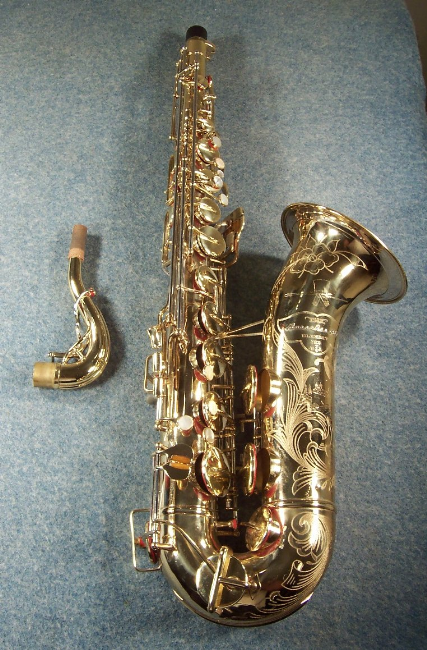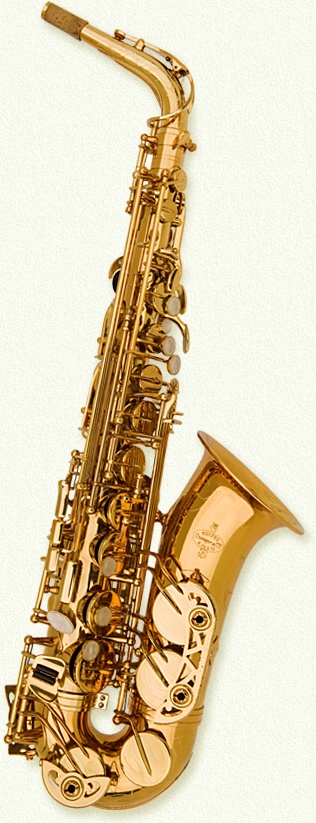
You might see one of these only in a museum one day or add this one to your own. Electronics this old often need the caps to be upgraded to prevent Hum and other issues. I can not be sure it is working the same as new. This system can also be used with other saxophones if you get a mouthpiece fitted with a mic. I can not verify the electronics operation since it is that old. The Amp looks new but has been in storage since the 60’s. The amp comes with what I think is a reverb box that plugs into the back of the amp. The amp played through and I could vary the sound with the switches and knobs. I did not do any testing of the Tenor kit. These look new although I connected up the alto to see if the amp worked. There are two kits: an Alto and a Tenor kit with Buescher 400 necks, cables and control boxes that mounted on the key guards for both.
#BUESCHER SUPER 400 ALTO SAXOPHONES SERIES#
This set up was for the Buescher 400 series and includes kits for converting the standard sax by changing the necks and adding the Amp interface. Built in the 60’s by Selmer an amp and interface for modifying the sound coming out of woodwinds and brass instruments. This is how the seller describes the most interesting find: That would have been a shame, because this minty Buescher Varitone amp and 2 control units (1 for tenor and another for alto), appear to be very fine indeed. There were three styles available: Brass with nickel, Silver plate, and silver plate with nickel bell called Super 400.One of the vintage sax players/owners/enthusiasts, who regularly stays in touch with me, sent me a link to an auction that I surely would have missed.

These are more modern sounding and good for big band jazz. After the traditional Truetone line of trumpets came the Buescher 400s.
#BUESCHER SUPER 400 ALTO SAXOPHONES PROFESSIONAL#
The Aristocrat was a Truetone professional trumpet previous to the Selmer buy out and became a student horn sometime after 1963. Louis Armstrong recorded with a Buescher Truetone 10-22R Trumpet in the late 1920s. There were a wide variety of Truetone models many custom made for the professional musician. Similar instruments were also produced by Gretsch and Supertone, although these could be stencils of the Buescher.īuescher Bb Truetone (Professional) was their main line of instruments during the 1920 until the 1940s. They were produced with the Albert system, and later with the Boehm System. It also produced some flutes and clarinets between 19, the Saxonette (also known as the "clariphon" and the "claribel"), a clarinet with a curved metal barrel and a curved metal bell pitched in A, Bb, C or Eb. It is believed that Buescher was the first company to produce them in America. Though Buescher manufactured many kinds of brass instruments, the company was known primarily for its saxophones which competed successfully with Conn and Martin. The Buescher line eventually faded and became the Bundy line. The quality level of the Buescher horns gradually decreased after the Selmer buyout as Selmer USA began to concentrate on the student horn market. After the sale Selmer restricted the use of the Buescher trademark to selected products, and rebranded some instruments with other names. In 1926 Buescher Band Instrument Company was joined with the Elkhart Band Instrument Company (some claim that Buescher was bought by Elkhart Band Instrument), a company founded two years previously by Beardsley. Buescher was vice-president and general manager of the company until January 21st 1929 when he resigned these positions, remaining on staff as a consultant engineer. Buescher remained president until 1919 when Beardsley assumed that title. In 1916 Buescher sold a major share of his company to six businessmen including Andrew Hubble Beardsley. After the reorganization, the company limited itself to producing band instruments. In 1904 the business was reorganized and renamed the Buescher Band Instrument Company. In 1903 there was a disastrous bank crash which affected Buescher's factory and a number of other local businesses. In March 1901 he patented a cornet unusual in that the valves were of unequal lengths. Main Street which made band instruments and other metal products, in partnership with John L Collins, a clothing merchant, and Harry L Long, a salesman. In the fall of 1894 he opened the Buescher Manufacturing Company at 1119 N. In 1890 while still employed with Conn, he began producing band emblems at home and was setting up his own shop. Conn's fledgling band instrument factory, and in 1888 he was promoted to foreman.


He accompanied his family to Goshen Indiana and then to Elkhart in 1875. Ohio 26 April 1861 died Elkhart Indiana 29 November 1937).

The company was founded by Ferdinand August "Gus" Buescher (born Elk Township,Noble Co.


 0 kommentar(er)
0 kommentar(er)
